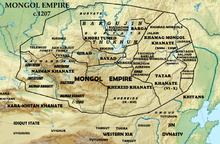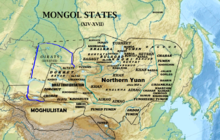This is an old revision of this page, as edited by Niceguyedc (talk | contribs) at 16:12, 5 March 2015 (WPCleaner v1.34 - Repaired 1 link to disambiguation page - (You can help) - Mongolian Khaganate). The present address (URL) is a permanent link to this revision, which may differ significantly from the current revision.
Revision as of 16:12, 5 March 2015 by Niceguyedc (talk | contribs) (WPCleaner v1.34 - Repaired 1 link to disambiguation page - (You can help) - Mongolian Khaganate)(diff) ← Previous revision | Latest revision (diff) | Newer revision → (diff) Ethnic group| Regions with significant populations | |
|---|---|
| few hundreds? | |
| Languages | |
| West Tümed: West Tümed-Ordos dialect of Mongolian; many speak Jin Chinese East Tümed: Kharchin dialect (Tümed subdialect) of Mongolian | |
| Religion | |
| Tibetan Buddhism, Shamanism , Atheism | |
| Related ethnic groups | |
| Mongols, Inner Mongolians | |


The Tümed (Tumad, "The many or ten thousands" derived from Tumen) are a Mongol subgroup. They live in Tumed Left Banner, district of Hohhot and Tumed Right Banner, district of Baotou. Most engage in sedentary agriculture, living in mixed communities in the suburbs of Huhhot. Part of them live along Hulun Buir, Inner Mongolia. There are the Tumeds in the soums of Mandal-Ovoo, Bulgan, Tsogt-Ovoo, Tsogttsetsii, Manlai, Khurmen, Bayandalai and Sevrei of Umnugovi Aimag, Mongolia.
At the beginning of the 9th – 13th Centuries, the Khori-Tumed lived near the western side of Lake Baikal. They ruled southern Irkutsk Oblast, some part of Tuva and southwestern Buryatia. In 1207, Genghis Khan, after conquering the Khori-Tumed, decided to move some of these groups south and these people eventually settled in the southern parts of the Great Gobi. But it seems that the Tumed people had no strong connection with those forest people in Siberia.
The Tumeds first appeared as the tribe of the Mongolian warlord Dogolon taishi in the mid-15th century. In Mongolian chronicles, they were called seven Tumeds or twelve Tumeds. Because the Kharchin and other Mongol clans joined their league, they were probably called 12 Tumeds later. Under Dayan Khan (1464-1517/1543) and his successors, the Tumeds formed right wing of the eastern Mongols. The Tumeds reached their peak under the rule of Altan Khan (1507–1582) in the mid-16th century. They raided the Ming Dynasty and looted the Four Oirats. The Tumeds under Altan Khan recaptured Karakorum from the hands of the Oirats but the outcome of the war was not decisive in the 16th century. They are also famous for being the first of the Mongol tribes converted to Buddhism.
They submitted to the Qing Dynasty and allied against the Chahar Mongols in the early 17th century. They were included in Josotu league of the Qing.
The Tumed were Sinicized linguistically in the late 19th century, and by the early 20th century. Many of their leaders rose to the very top government, party, and military positions in the newly rounded IMAR, and some attained leading national posts in Beijing and elsewhere. Ulanhu (1906–1988), a Tumed Mongol born near Huhhot, the capital of Inner Mongolia, who dominated the politics of the region until his death in 1989, and was the highest-ranking Mongol in the Communist Party of China. After the 1920s, as the Tumed began to interact with other Mongols, they began to feel an acute sense of inadequacy regarding their Mongolian language skills. In the 1950s, they set up many nationality (minzu) primary schools and middle schools that recruited only Mongolian students. In these schools, Mongolian was taught as a subject, one considered of equal importance to Chinese, though all other subjects were taught in Chinese. During the Cultural Revolution years, 1966–76, Mongolian instruction was largely abolished. A new attempt to provide a Mongol education began in September 1979.
The Tumed banner built a "Mongolian Nationality Primary School" in October 1982 in the banner center. The school then had eight classes divided into three grades, with 201 boarding pupils, all taught in Mongolian. Interestingly, Chinese was taught only from grade 5, the students were not allowed to leave the compound without permission, and, during vacations, they were often sent to the grassland to learn directly from pure Mongol-speaking herders, lest they be contaminated by their Chinese-speaking parents and relatives or Chinese neighbors.
Notes
- History of Mongolia, Volume II, 2003
- Huhehaote 2000
- Tumote 1987:634-659
External links
- Монгол угсаатны хэлний бүрэлдэхүүн in Mongolian
| Mongolic peoples | |||||||||||
|---|---|---|---|---|---|---|---|---|---|---|---|
| History | |||||||||||
| Proto-Mongols | |||||||||||
| Medieval tribes | |||||||||||
| Ethnic groups |
| ||||||||||
| See also: Donghu and Xianbei · Turco-Mongol · Modern ethnic groups Mongolized ethnic groups.Ethnic groups of Mongolian origin or with a large Mongolian ethnic component. | |||||||||||